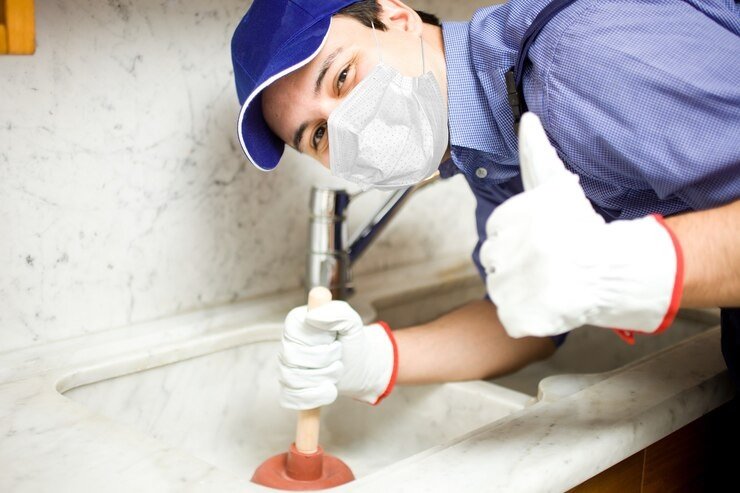Clogged drains and pipes are a nuisance that can quickly turn into a soggy, sudsy mess. Few things are more annoying than standing in ankle-deep water because the bath won’t drain or finding dirty water bubbles up from the kitchen sink when you turn on the tap. Fortunately, in many cases, you can unclog drains yourself without calling for professional help.
This article will explore the common causes of clogged drains and outline several DIY methods you can use to clear out the gunk and get your drains flowing freely again. You’ll also learn some tips for preventing future clogs. With a few simple tools and ingredients commonly found around the house, you can master the art of DIY drain unclogging. So grab your rubber gloves and get ready to clear those pipes!
Why Drains Get Clogged in the First Place?
Before diving into the different methods for clearing a clog, it helps to understand what causes drains to get backed up.
Hair: Showers and sinks often become clogged with loose strands of hair. As hair washes down the drain, it can get tangled together and collect other debris to form a large clump that blocks the pipe.
Soap scum: The fatty acids in soap can build up on the insides of drains and pipes over time. This sticky scum catches other debris passing through and can create a stubborn clog.
Food particles: Leftover scraps like grease, oil, coffee grounds, and small chunks of food can stick to pipes and cause a blockage. Garbage disposals can make the problem worse if not used properly.
Grease and oil: Grease pours down drains easily when warm, but then coagulates and sticks to pipes as it cools. This grease buildup accumulates over time. Hard water areas tend to produce limescale deposits inside pipes and drains. These mineral deposits restrict water flow and make clogs more likely.
Tree roots: If a drain or sewer line runs underground outside your home, it can be invaded by root growth from nearby trees and bushes. The roots constrict the pipe openings. Any objects accidentally dropped down drains, like toys, hygiene products, and debris, can get lodged in the pipes and cause clogging. Drain screens can prevent these issues.
With regular drain maintenance and some care, many of these clogs can be avoided altogether. Best practices include removing hair and food from drains quickly, limiting grease poured, using drain screens, avoiding putting solids down the garbage disposal, and having pipes cleaned periodically.
6 DIY Methods to Unclog Drains
When you notice the first signs of a slow drain, like gurgling sounds or slowly draining water, unclogging the pipe right away can help avoid a complete blockage. Here are 6 DIY methods you can try to dissolve, dislodge, or remove clog-causing buildup:
1. Baking Soda and Vinegar
This classic DIY drain unclogger combines the effervescent reaction between baking soda (sodium bicarbonate) and vinegar (acetic acid) to break up mild clogs. Here’s how to do it:
You’ll need:
- 1 cup baking soda
- 1 cup white vinegar
- Teakettle or pot of boiling water
- Plunger
- Drain cover or stopper
Steps:
- Pour 1 cup of baking soda down the drain and let it sit for a few minutes.
- Follow with 1 cup of vinegar and immediately cover the drain tightly. This triggers the fizzy chemical reaction between the base and acid.
- Let the mixture sit for 5-10 minutes to work on clogs.
- Flush the drain with boiling water from a kettle or pot to help dissolve any remaining buildup.
- Use a plunger up and down in the drain 10-15 times to force through any loosened debris.
- Flush with more hot water.
- Repeat as needed for stubborn clogs.
The combination of heat, pressure, and chemical reaction breaks up mild soap scum, grease, hair, and food clogs. Just take care opening the drain initially to prevent hot vinegar from splashing out.
2. Baking Soda and Salt
For a variation, mix in some table salt with the baking soda. The abrasive grains of salt can help scour away residue clinging to the pipes. Follow the same steps as above, substituting 1/2 cup salt for 1/2 cup of the baking soda before pouring it down the drain. The salt boosts the cleaning power but can still be harmless to pipes.
3. Boiling Water
For simple organic clogs, a pot or kettle of hot water may be all you need. Boiling water can melt and wash away grease or soap buildup.
Steps:
- Boil a full pot or kettle of water.
- Carefully pour it slowly down the drain. Caution – the hot water can splash easily.
- Let it sit for a few minutes to clear debris.
- Flush with more boiling water.
- Use a plunger in the drain as a final step to clear the loosened clog.
Repeat as needed, waiting several minutes between each pot of water for it to work. The key is using fully boiling water to melt the clogging material. Finish up with cold water to solidify the grease and send it down the pipes.
4. Plunger
Using a simple sink or drain plunger can provide enough suction to dislodge a clog after loosening it up first.
You’ll need:
- Plunger
- Bucket
- Hot water
Steps:
- Fill the blocked sink with hot water and tightly seal the drain opening around the plunger.
- Quickly plunge the drain up and down 15-20 times in rapid succession.
- Repeat 3-4 times, refilling the sink with hot water each time.
- If needed, fill the sink to overflowing with hot water and seal the plunger for a stronger suction effect.
- Finish by running cold water down the drain to rinse away debris.
The up and down motion generates both suction and pressure to force debris through the pipes and down the drain. Take care not to scratch enamel or porcelain surfaces with the plunger.
5. Drain Snake/Auger
For deeper clogs, a drain snake can physically grab and pull out the blockage. Feed a coiled metal snake down the pipes and twist to snag hair, debris, or grease, pulling it back out. This inexpensive DIY drain cleaning tool is available at hardware stores.
You’ll need:
- Drain snake/auger
- Bucket
- Gloves
Steps:
- Place a bucket under the sink to catch drips.
- Feed the end of the snake down the drain and crank the handle clockwise while pushing forward slowly.
- Once it hits the clog, crank the handle back and forth while retrieving the snake to hook into the debris.
- Pull out the snake and clean off any grime.
- Repeat running hot water between attempts to flush loose particles away.
- Clean off any debris left in the sink.
Snaking smaller handheld drain snakes down shower or tub drains can also retrieve globs of hair and soap scum, causing clogs. Always wear gloves since you never know what you’ll hook!
6. Chemical Drain Cleaners
Liquid drain cleaner chemicals are a more caustic option when DIY methods don’t work. Look for enzyme cleaners or milder products first. Follow product instructions carefully.
You’ll need:
- Drain cleaner chemical
- Bucket
- Gloves & eye protection
Steps:
- Wear gloves and eye protection for safety when handling corrosive cleaners.
- Shake the bottle well and pour the directed amount down the drain. Avoid splashing.
- Let the chemical cleaner sit for the recommended time to work (usually 15 minutes to an hour).
- Flush the drain thoroughly with cold water for 5 minutes to rinse away residue. Hot water triggers toxic fumes.
- Repeat if needed for stubborn clogs, waiting several hours between treatments.
- Open windows and turn on fans since the fumes can be strong. Never mix chemical products!
The caustic agents dissolve organic matter, especially when left to soak overnight for a serious clog. Just take care, since the chemicals can damage pipes if overused. Only use once other methods fail.
When It’s Time to Call a Professional
While many basic household clogs can be cleared with some DIY elbow grease, there are times to call for the experts:
- Water overflows from drains anywhere in your home. Serious backups can cause flooding damage if not addressed quickly.
- Multiple drains are slow all over the house. This points to a main sewer line issue.
- Outdoor drains, like basement sinks or sewer lines, are clogged. Outdoor pipe issues often require professional equipment.
- DIY methods fail to open the clog after several attempts. Stubborn clogs may need a professional hydrojetting.
- Clogs recur shortly after DIY clearing. There may be a bigger underlying problem.
- You suspect the clog may be further down the main line. Roots or collapsed pipes need excavation.
- Sewage is backing up, or you have a sewer gas smell. Sewer line clogs can be hazardous.
- Your pipes were never properly installed, or are old and damaged. Faulty drain connections need repair.
- The clog is in a sink, tub, or appliance that cannot be easily accessed. Proper access is needed.
While professional drain cleaning services cost more, they can provide the advanced equipment and expertise to fully clear out problem clogs and inspect your entire drain system. A camera scope of your pipes can reveal issues like tree root invasions, broken pipes, and misaligned joints. The right repairs will prevent future clogging.
Local contractors who pair camera inspection with hydrojetting and slab-leak detection can often fix the root cause on the same visit, saving time and preventing repeat clogs. If you need a prompt, licensed response—especially for backups or sewage odors—look for a team that offers emergency dispatch, clear estimates, and camera diagnostics. By opting to only work with the best plumber in Winder, GA (or elsewhere) available, you’ll likely be able to gain access to 24/7 troubleshooting and comprehensive services like water heater and repiping work. Choosing a provider that documents issues with video and outlines repair options helps you prioritize fixes and avoid unexpected costs.
Keep Drains Flowing Freely With Preventive Care
While it’s handy to know various DIY drain unclogging methods for when clogs arise, prevention is the best long-term solution. Here are some tips to keep your drains clear and maintain free flow:
- Use drain screens and catchers to block loose hair and debris from going down the drain initially. Clean them out regularly.
- Avoid pouring fats, oils, and grease down sinks. Scrape plates and cookware, and dispose of grease in the trash instead.
- Limit the use of your garbage disposal. Compost scraps when possible rather than grinding them up.
- Only use your toilet for human waste and toilet paper. Items like tissues, wipes, and hygiene products clog pipes over time.
- Rinse fruit skins, eggshells, and small particles off dishes instead of washing them down with a strong stream of water.
- Periodically flush drains with hot water, baking soda, and vinegar to keep pipes clear, especially after preparing greasy foods.
- Have your sewer and drain system professionally inspected every 2 years and use a camera scope to identify any damaged spots proactively.
- Replace old pipes. Old cast-iron or clay pipes allow debris and roots to intrude more easily.
Regular drain maintenance, like using enzyme cleaners or flushing with hot water weekly, can keep your pipes gunk-free. While DIY drain clearing can work for basic clogs, don’t hesitate to call a professional if needed. Investing in professional drain cleaning periodically can avoid major pipe damage down the road.
The Takeaway
In summary, clogged drains don’t have to leave you high and dry. With some simple hardware store ingredients and tools like baking soda, vinegar, boiling water, and a plunger, you can break up mild clogs and keep your home’s plumbing flowing freely. For more stubborn obstructions, a drain snake or mild chemical cleaner may do the trick.
Knowing when to call for professional help is also key to preventing water damage and sewer gas hazards. But armed with a range of DIY methods, you can clear slow-running drains yourself and get things moving again. Just be sure to take steps to prevent future clogs by cleaning pipes regularly and using drain catchers. With some simple knowledge, you can tackle clogged drains yourself and keep your pipes clear.




No Comment! Be the first one.